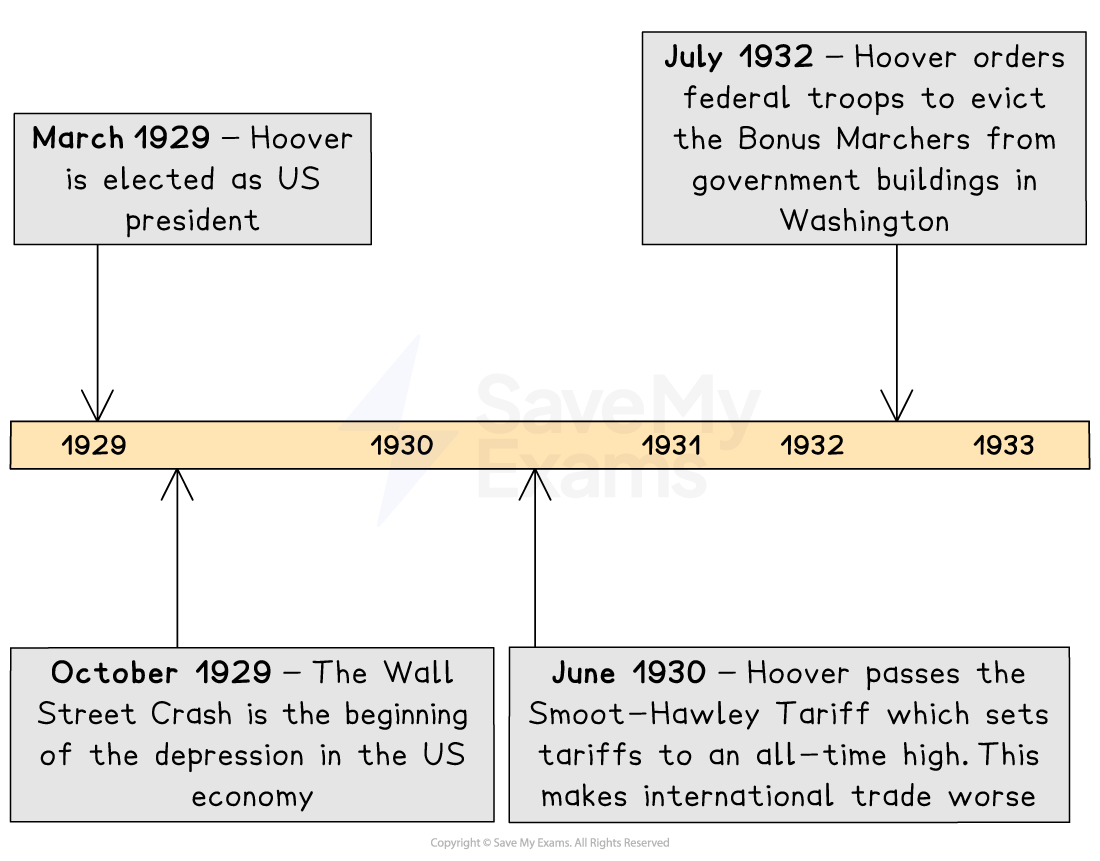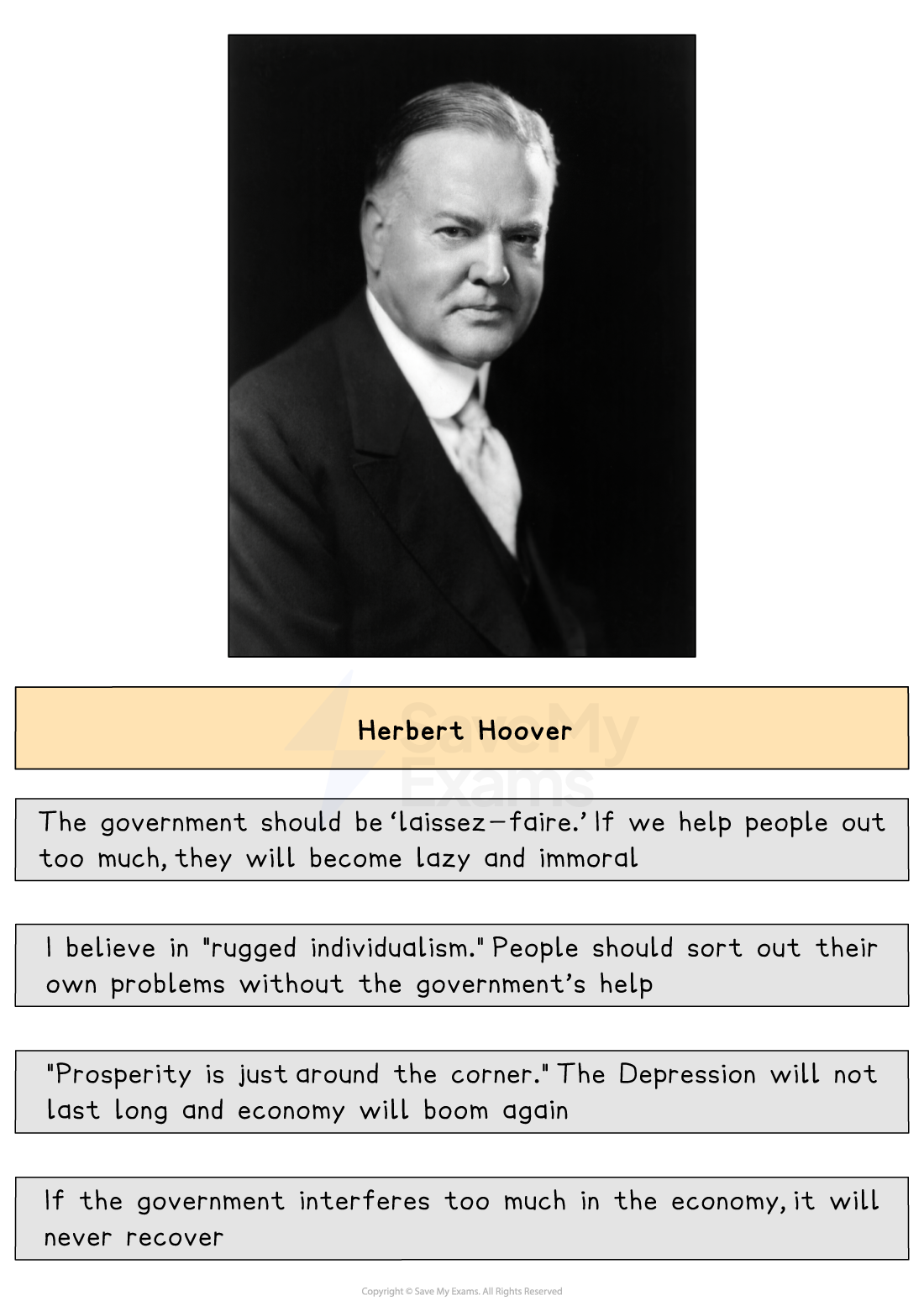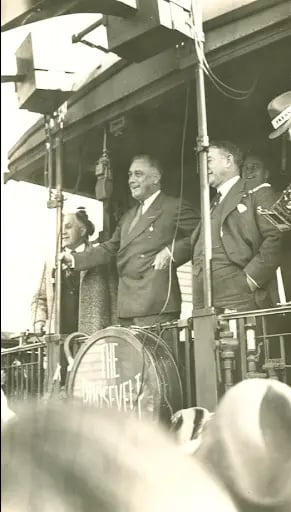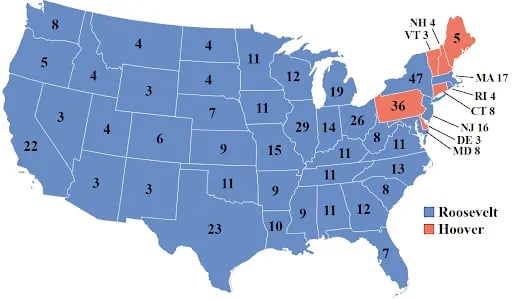Why Did Roosevelt Win the Election of 1932? (Cambridge (CIE) IGCSE History): Revision Note
Exam code: 0470 & 0977
Timeline & Summary

President Herbert Hoover believed that every American should be free to succeed — or fail — on their own merits. The US was the land of the “American Dream”, where anyone could become rich through hard work. Hoover believed that the government should stay out of people’s lives and let them get on with it.
This was a very popular policy in the 1920s when things were booming. People didn’t need the government's help, and they appreciated the low taxes. However, when disaster struck and the stock market crashed in October 1929, people’s attitudes changed. Unfortunately, President Hoover’s didn’t.
Hoover believed that people should look to themselves to solve their problems, not the government. He eventually changed his mind and introduced a series of measures to help people, but it was too late to stop him from becoming very unpopular with the American people. When he used force against some Army veterans campaigning for financial help, he became even more unpopular.
Hoover’s opponent in the 1932 presidential election was Franklin D. Roosevelt. He was a great public speaker and promised to help people out of the Great Depression. The result was a defeat for Herbert Hoover and the election of Roosevelt as president.
Hoover’s beliefs

The reaction of President Hoover to the Crash
Initially, Hoover did very little in reaction to the Crash
He believed it was wrong for the government to step in to help and thought that self-reliance or “rugged individualism” would pull America through
In January 1930, he declared to the American people that “we have now passed the worst”
It soon became clear that things were getting much worse and that Hoover had misread the situation terribly
Between 1930 and 1932, Hoover introduced a number of measures and initiatives to improve the US economy
These included:
A tax cut of $130million, which allowed people to keep more of the money they earned
A road- and dam-building programme to create employment for construction workers
The Smoot-Hawley tariff, which increased the price of foreign imports
This was intended to make Americans buy more US goods, but it caused foreign countries to introduce tariffs on US goods
As a result, US exports collapsed, and companies went bust
He made $300 million available to help unemployed people
These actions were not enough to mend the damage done by his early inaction
Many Americans saw him as being out of touch with the reality of the situation and uncaring about their suffering
The Bonus Marchers
Hoover’s attitude and actions towards the Bonus Marchers damaged his reputation even further
The Bonus Marchers were a group of 25,000 First World War veterans who wanted their war pension (or bonus) paid immediately rather than in 1945
When this was refused, they marched to Washington, DC, and set up a Hooverville directly outside the White House in March 1932
Hoover decided to remove the Bonus Marchers by force
The Army used tear gas and tanks to move the Bonus Marchers
The US army killed two protestors and a baby
More than 1,000 people were injured
Hoover’s approach shocked many US citizens because:
US society treated veterans with the utmost respect due to their service
People believed this proved that Hoover did not care about US citizens
He was unwilling to give support to ex-soldiers who served to protect the US
The incident made people determined to vote against Hoover in the next election
1932 was an election year
Hoover’s actions against patriotic Americans made him even more unpopular with the public
Roosevelt’s campaign
Hoover’s opponent in 1932 was the Democratic presidential candidate Franklin D. Roosevelt
Unlike Hoover, Roosevelt ran an election campaign that won the hearts and minds of millions of struggling Americans
Roosevelt’s tactics and why they were effective
Roosevelt was an excellent orator
He travelled 20,000 km by train across the country, making speeches
People listened to Roosevelt’s vision for the US; he seemed like he cared about the American people
Roosevelt promised that his government would help the “forgotten man”
Many people in the US felt like the “forgotten man” — they trusted that Roosevelt would help them recover from the economic crisis
Roosevelt highlighted his own struggles
He was disabled after suffering from polio at the age of 39
The US public believed that Roosevelt understood what it was like to go through suffering
Hoover’s backstory as a self-made millionaire was unrelatable to most people in the US
Roosevelt promised a “New Deal” to resolve the Depression
He promised to create government schemes to provide more jobs and revive industry and farming
He wanted to provide help for those on low incomes and without jobs and to improve worker protection; he promised to end Prohibition
The American people liked Roosevelt’s ideas
They recognised that Roosevelt had listened to the concerns of the people and knew how to resolve them

The 1932 presidential election
The result was victory for Roosevelt in the biggest landslide in US history
Roosevelt won 8 million more votes than Hoover
Roosevelt won the vote in 48 states
Hoover won in just six

Worked Example
Describe the attempts made by Hoover to deal with the effects of the Depression.
[4 marks]
Answer:
One attempt made by Hoover to deal with the effects of the Depression was the introduction of an enormous road- and dam-building programme. This required the employment of large numbers of construction workers who would probably otherwise have been unemployed.
Another attempt made by Hoover to deal with the effects of the Depression was the introduction of the Smoot–Hawley Tariff. This placed a tariff on imported foreign goods, making them more expensive and making US-made goods more appealing to American shoppers. However, other countries introduced tariffs on US goods in response, which caused US exports to collapse
Examiner Tips and Tricks
Two well-chosen points with good explanations are all you need to get maximum marks on a 4-mark question. Don’t waste time or effort writing more, as you will not be rewarded for it

Unlock more, it's free!
Did this page help you?